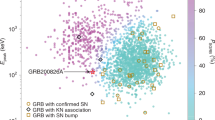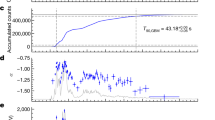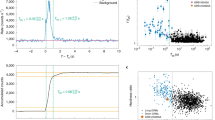Abstract
It is now accepted that long-duration γ-ray bursts (GRBs) are produced during the collapse of a massive star1,2. The standard ‘collapsar’ model3 predicts that a broad-lined and luminous type Ic core-collapse supernova accompanies every long-duration GRB4. This association has been confirmed in observations of several nearby GRBs5–9. Here we report that GRB 060505 (ref. 10) and GRB 060614 (ref. 11) were not accompanied by supernova emission down to limits hundreds of times fainter than the archetypal supernova SN 1998bw that accompanied GRB 980425, and fainter than any type Ic supernova ever observed12. Multi-band observations of the early afterglows, as well as spectroscopy of the host galaxies, exclude the possibility of significant dust obscuration and show that the bursts originated in actively star-forming regions. The absence of a supernova to such deep limits is qualitatively different from all previous nearby long-duration GRBs and suggests a new phenomenological type of massive stellar death.
This is a preview of subscription content, access via your institution
Access options
Subscribe to this journal
Receive 51 print issues and online access
$199.00 per year
only $3.90 per issue
Buy this article
- Purchase on Springer Link
- Instant access to full article PDF
Prices may be subject to local taxes which are calculated during checkout

Similar content being viewed by others
References
Zeh, A., Klose, S. & Hartmann, D. H. A systematic analysis of supernova light in gamma-ray burst afterglows. Astrophys. J. 609, 952–961 (2004)
Woosley, S. E. & Bloom, J. S. The supernova–gamma-ray burst connection. Annu. Rev. Astron. Astrophys. 44, 507–556 (2006)
Woosley, S. E. Gamma-ray bursts from stellar mass accretion disks around black holes. Astrophys. J. 405, 273–277 (1993)
MacFadyen, A. I. & Woosley, S. E. Collapsars: Gamma-ray bursts and explosions in “failed supernovae”. Astrophys. J. 524, 262–289 (1999)
Galama, T. J. et al. An unusual supernova in the error box of the gamma-ray burst of 25 April 1998. Nature 395, 670–672 (1998)
Hjorth, J. et al. A very energetic supernova associated with the γ-ray burst of 29 March 2003. Nature 423, 847–850 (2003)
Stanek, K. Z. et al. Spectroscopic discovery of the supernova 2003dh associated with GRB 030329. Astrophys. J. 591, L17–L20 (2003)
Malesani, D. et al. Astrophys. J. 609, L5–L8 (2004)
Pian, E. et al. An optical supernova associated with X-ray flash 060218. Nature 442, 1011–1013 (2006)
Hullinger, D. et al. GRB 060505 BAT refined analysis. GCN Circ. 5142, (2006)
Gehrels, N. et al. A new γ-ray burst classification scheme from GRB 060614. Nature doi: 10.1038/nature05376 (this issue); preprint at 〈http://arxiv.org/astro-ph/0610635〉 (2006)
Richardson, D., Branch, D. & Baron, E. Absolute magnitude distributions and light curves of stripped-envelope supernovae. Astron. J. 131, 2233–2244 (2006)
Ofek, E. O. et al. GRB 060505 - OT candidate + galaxy spectrum. GCN Circ. 5123, (2006)
Gal-Yam, A. et al. A novel explosive process is required for the γ-ray burst GRB 060614. Nature doi: 10.1038/nature05373 (this issue); preprint at 〈http://arxiv.org/astro-ph/0608257〉 (2006)
Della Valle, M. et al. An enigmatic long-lasting γ-ray burst not accompanied by a bright supernova. Nature doi: 10.1038/nature05374 (this issue); preprint at 〈http://arxiv.org/astro-ph/0608322〉 (2006)
Schlegel, D. J., Finkbeiner, D. P. & Davis, M. Maps of dust infrared emission for use in estimation of reddening and cosmic microwave background radiation foregrounds. Astrophys. J. 500, 525–553 (1998)
Holland, S. T. GRB 060614: Swift/UVOT Observations. GCN Circ. 5255, (2006)
Fruchter, A. S. et al. Long gamma-ray bursts and core-collapse supernovae have different environments. Nature 441, 463–468 (2006)
Sollerman, J. et al. On the nature of nearby GRB/SN host galaxies. New Astron. 11, 103–115 (2005)
Sollerman, J. et al. Supernova 2006aj and the associated X-ray flash 060218. Astron. Astrophys. 454, 503–509 (2006)
Soderberg, A. M. et al. An HST study of the supernovae accompanying GRB 040924 and GRB 041006. Astrophys. J. 636, 391–399 (2006)
Ferrero, P. et al. The GRB 060218/SN 2006aj event in the context of other gamma-ray burst supernovae. Astron. Astrophys. 457, 857–864 (2006)
Levan, A. et al. A deep search with the Hubble Space Telescope for late-time supernova signatures in the hosts of XRF 011030 and XRF 020427. Astrophys. J. 622, 975–985 (2005)
Soderberg, A. M. et al. An HST search for supernovae accompanying X-ray flashes. Astrophys. J. 627, 877–887 (2005)
Fynbo, J. P. U. et al. On the afterglow of the X-ray flash of 2003 July 23: photometric evidence for an off-axis gamma-ray burst with an associated supernova? Astrophys. J. 609, 962–971 (2004)
Fryer, C. L., Young, P. A. & Hungerford, A. L. Explosive nucleosynthesis from GRB and hypernova progenitors: direct collapse versus fallback. Astrophys. J. 650, 1028–1047 (2006)
Heger, A. et al. How massive single stars end their life. Astrophys. J. 591, 288–300 (2003)
MacFadyen, A. I. in AIP Conf. Proc. 662: Gamma-Ray Burst and Afterglow Astronomy 2001: A Workshop Celebrating the First Year of the HETE Mission (November 2001) (eds Ricker, G. R. & Vanderspek, R. K.) 202–205 (American Institute of Physics, Melville, New York, 2003)
Schmidt, B. P. et al. SSO 1m observations. GCN Circ. 5258, (2006)
Pedersen, H. et al. Evidence for diverse optical emission from gamma-ray burst sources. Astrophys. J. 496, 311–315 (1998)
Acknowledgements
We acknowledge benefits from collaboration within the EU FP5 Research Training Network “Gamma-Ray Bursts: An Enigma and a Tool”. The Dark Cosmology Centre is funded by the DNRF. The observations presented here have been obtained from the ESO La Silla-Paranal observatory and from the Gemini Observatory. The Gemini Observatory is operated by the Association of Universities for Research in Astronomy, Inc., under a cooperative agreement with the NSF on behalf of the Gemini partnership: the National Science Foundation (USA), the Particle Physics and Astronomy Research Council (UK), the National Research Council (Canada), CONICYT (Chile), the Australian Research Council (Australia), CNPq (Brazil), and CONICET (Argentina).
Author information
Authors and Affiliations
Corresponding author
Ethics declarations
Competing interests
Reprints and permissions information is available at www.nature.com/reprints. The authors declare no competing financial interests.
Supplementary information
Supplementary Information
This file contains Supplementary Tables 1 and 2, Supplementary Notes and Supplementary Figures 1 and 2 with legends.
Rights and permissions
About this article
Cite this article
Fynbo, J., Watson, D., Thöne, C. et al. No supernovae associated with two long-duration γ-ray bursts. Nature 444, 1047–1049 (2006). https://doi.org/10.1038/nature05375
Received:
Accepted:
Issue Date:
DOI: https://doi.org/10.1038/nature05375
This article is cited by
-
A long-duration gamma-ray burst with a peculiar origin
Nature (2022)
-
A deep study of the high–energy transient sky
Experimental Astronomy (2021)
-
Ontological Categorizations and Selection Biases in Cosmology: The Case of Extra Galactic Objects
Foundations of Science (2021)
-
Detection of short high-energy transients in the local universe with SVOM/ECLAIRs
Astrophysics and Space Science (2020)
-
The Macronova in GRB 050709 and the GRB-macronova connection
Nature Communications (2016)
Comments
By submitting a comment you agree to abide by our Terms and Community Guidelines. If you find something abusive or that does not comply with our terms or guidelines please flag it as inappropriate.



